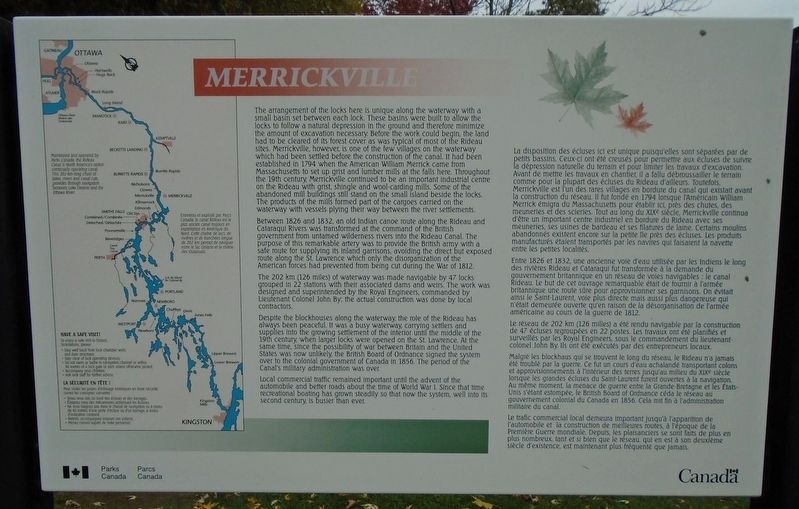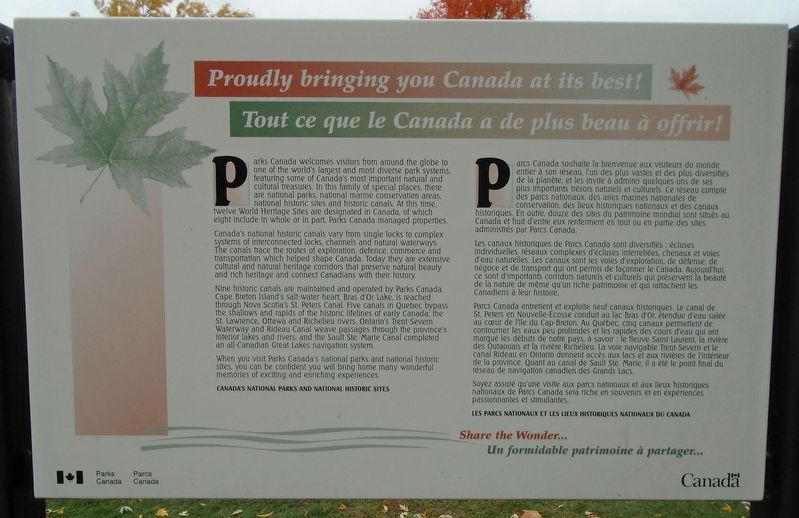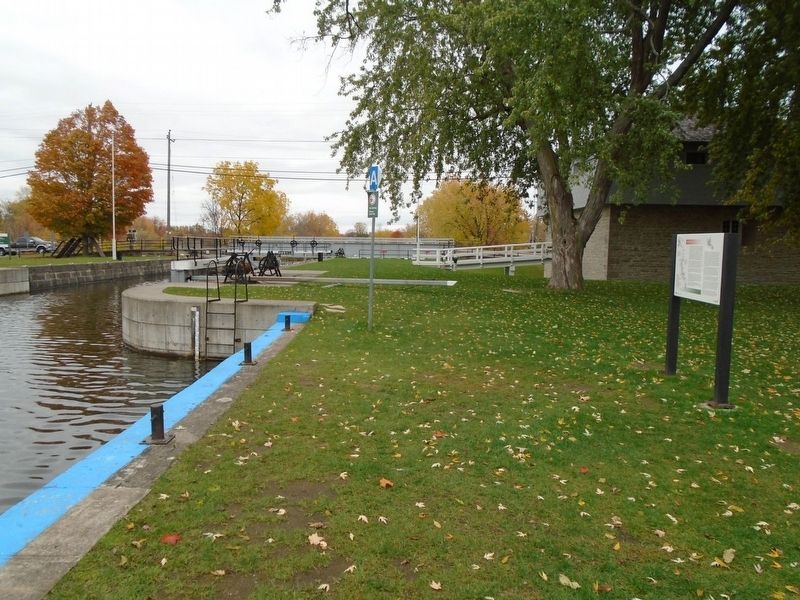Merrickville
The arrangement of the locks here is unique along the waterway with a small basin set between each lock. These basins were built to allow the locks to follow a natural depression in the ground and therefore minimize the amount of excavation necessary. Before the work could begin, the land had to be cleared of its forest cover as was typical of most of the Rideau sites. Merrickville, however, is one of the few villages on the waterway which had been settled before the construction of the canal. It had been established in 1794 when the American William Merrick came from Massachusetts to set up grist and lumber mills at the falls here. Throughout the 19th century, Merrickville continued to be an important industrial centre on the Rideau with grist, shingle and wool-carding mills. Some of the abandoned mill buildings still stand on the small island beside the locks. The products of the mills formed part of the cargoes carried on the waterway with vessels plying their way between the river settlements.
Between 1826 and 1832, an old Indian canoe route along the Rideau and Cataraqui Rivers was transformed at the command of the British
government from untamed wilderness rivers into the Rideau Canal. The purpose of this remarkable artery was to provide the British army with a safe route for supplying its inland garrisons, avoiding the direct but exposed route along the St. Lawrence which only the disorganization of the American forces had prevented from being cut during the War of 1812.The 202 km (126 miles) of waterway was made navigable by 47 locks grouped in 22 stations with their associated dams and weirs. The work was designed and superintended by the Royal Engineers, commanded by Lieutenant Colonel John By; the actual construction was done by local contractors.
Despite the blockhouses along the waterway, the role of the Rideau has always been peaceful. It was a busy waterway, carrying settlers and supplies into the growing settlement of the interior until the middle of the 19th century, when larger locks were opened on the St. Lawrence. At the same time, since the possibility of war between Britain and the United States was now unlikely, the British Board of Ordnance signed the system over to the colonial government of Canada in 1856. The period of the Canal's military administration was over.
Local commercial traffic remained important until the advent of the automobile and better roads about the time of World War I. Since that time recreational boating has grown steadily so that now the system,
La disposition des écluses ici est unique puisqu'elles sont séparées par de petits bassins. Ceux-ci ont été creusés pour permettre aux écluses de suivre la dépression naturelle du terrain et pour limiter les travaux d'excavation. Avant de mettre les travaux en chantier, il a fallu débroussailler le terrain comme pour la plupart des écluses de Rideau d'ailleurs. Toutefois, Merrickville est l'un des rares villages en bordure du canal qui existait avant la construction du réseau. Il fut fondé en 1794 lorsque l'Américain William Merrick émigra du Massachusetts pour établir ici, près des chutes, des meuneries et des scieries. Tout au long du XIXe siècle, Merrickville continua d'être un important centre industriel en bordure du Rideau avec ses meuneries, ses usines de bardeau et ses filature de laine. Certains moulins abandonnés existent encore sur la petite île près des écluses. Les produits manufacturés étaient transportés par les navires qui faisaient la navette entre les petites localités.
Entre 1826 et 1832, une ancienne voie d'eau utilisée par les Indiens le long des rivières Rideau et Cataraqui fut transformée à la demande du gouvernement britannique en un réseau de voies navigables
Le réseau de 202 km (126 milles) a été rendu navigable par la construction de 47 écluses regroupées en 22 postes. Les travaux ont été planifiés et surveillés par les Royal Engineers, sous le commandement du lieutenant-colonel John By. Ils ont été exécutés par des entrepreneurs locaux.
Malgré les blockhaus qui se trouvent le long du réseau, le Rideau n'a jamais été troublé par la guerre. Ce fut un cours d'eau achalandé transportant colons et approvisionnements à l'intérieur des terres jusqu'au milieu de XIXe siècle lorsque les grandes écluses du Saint-Laurent furent ouvertes à la navigation. Au même moment, la menace de guerre entre la Grand-Bretagne et les États-Unis s'étant estompée, le British Board of Ordnance céda le réseau au gouvernement colonial du Canada en 1856. Cela mit fin à l'administration militaire du canal.
Le trafic commercial local demeura important jusqu'à l'apparition de l'automobile et la construction de meilleures routes, à l'époque de la Première Guerre mondiale. Depuis, les plaisanciers se sont faits
de plus en plus nombreux, tant et si bien que le réseau, qui en est à son deuxième siècle d'existence, est maintenant plus fréquenté que jamais.Erected by Parks/Parcs Canada.
Topics. This historical marker is listed in these topic lists: Industry & Commerce • Parks & Recreational Areas • Settlements & Settlers • Waterways & Vessels. A significant historical year for this entry is 1794.
Location. 44° 54.99′ N, 75° 50.268′ W. Marker is in Merrickville, Ontario, in Leeds and Grenville United Counties. Marker is at the intersection of St. Lawrence Street (Provincial Highway 15/43) and Rideau Canal, on the right when traveling south on St. Lawrence Street. Touch for map. Marker is at or near this postal address: 279 St Lawrence Street, Merrickville ON K0G 1N0, Canada. Touch for directions.
Other nearby markers. At least 8 other markers are within walking distance of this marker. Twin Canals / Les canaux jumelés (a few steps from this marker); Canal Twins / Les canaux jumelés (a few steps from this marker); Dr. Jim Connor (a few steps from this marker); The Merrickville Blockhouse / Le blockhaus de Merrickville (within shouting distance of this marker); Blockhaus de Merrickville Blockhouse (within shouting distance of this marker); Merrickville Blockhouse 1832 (within shouting distance of this marker); 1st Merrickville Scout Group (within shouting distance of this marker); Merrickville United Church (about 90 meters away, measured in a direct line). Touch for a list and map of all markers in Merrickville.
Also see . . .
1. Merrickville-Wolford at Wikipedia. (Submitted on November 8, 2019, by William Fischer, Jr. of Scranton, Pennsylvania.)
2. Merrickville-Wolford. (Submitted on November 8, 2019, by William Fischer, Jr. of Scranton, Pennsylvania.)
3. Merrickville Historic Properties Walking Tour. (Submitted on November 8, 2019, by William Fischer, Jr. of Scranton, Pennsylvania.)
4. Rideau Canal National Historic Site. (Submitted on November 8, 2019, by William Fischer, Jr. of Scranton, Pennsylvania.)
Credits. This page was last revised on November 8, 2019. It was originally submitted on November 8, 2019, by William Fischer, Jr. of Scranton, Pennsylvania. This page has been viewed 108 times since then and 14 times this year. Photos: 1, 2, 3. submitted on November 8, 2019, by William Fischer, Jr. of Scranton, Pennsylvania.


